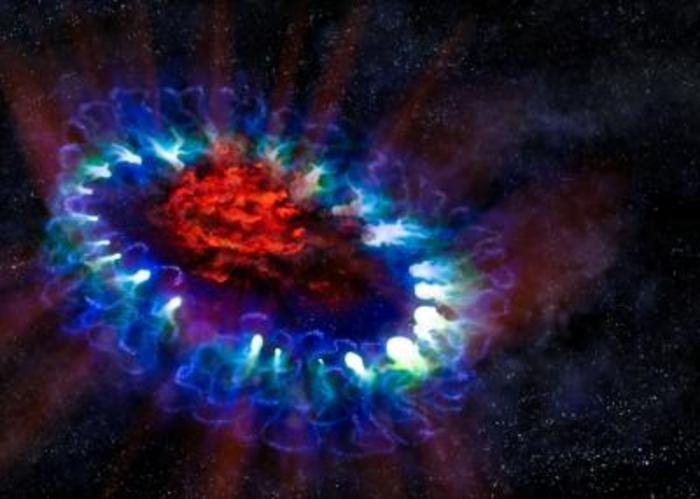Artist's illustration of supernova 1987A reveals the cold, inner regions of the exploded star's remnants (in red) where tremendous amounts of dust were detected and imaged by ALMA. This inner region is contrasted with the outer shell (white and blue circles), where the energy from the supernova is colliding with the envelope of gas ejected from the star prior to its powerful detonation. Credit: Alexandra Angelich (NRAO/AUI/NSF)
CHARLOTTESVILLE, Va., Jan. 6 (UPI) -- Supernovas are thought to be a primary source of dust in galaxies, and U.S. astronomers say the remains of a recent supernova are full of freshly formed dust.
Direct evidence of a supernova's dust-making capabilities has up to now been slim and cannot account for the copious amount of dust detected in young, distant galaxies, they said, but data from radio telescopes in Chile could explain how many galaxies acquire their dusty, dusky appearance.
"We have found a remarkably large dust mass concentrated in the central part of the ejecta from a relatively young and nearby supernova," Remy Indebetouw with the National Radio Astronomy Observatory and the University of Virginia said. "This is the first time we've been able to really image where the dust has formed, which is important in understanding the evolution of galaxies."
An international team of astronomers used the Atacama Large Millimeter/submillimeter Array to observe the glowing remains of supernova 1987A, which is in the Large Magellanic Cloud, a dwarf galaxy orbiting the Milky Way about 168,000 light-years from Earth.
They estimate the remnant now contains about 25 percent the mass of our sun in newly formed dust.
"1987A is a special place since it hasn't mixed with the surrounding environment, so what we see there was made there," Indebetouw said. "The new ALMA results, which are the first of their kind, reveal a supernova remnant chock full of material that simply did not exist a few decades ago" from an Earth-observation standpoint, which saw the light from the exploding supernova reach the Earth in 1987.
Such processes could account for the large amount of dust astronomers detect in the early universe, the researchers said.
"Really early galaxies are incredibly dusty and this dust plays a major role in the evolution of galaxies," Mikako Matsuura of University College London said. "Today we know dust can be created in several ways, but in the early universe most of it must have come from supernovas. We finally have direct evidence to support that theory."















